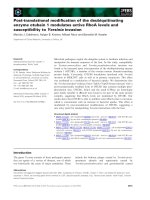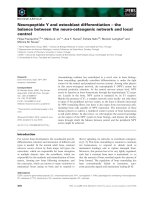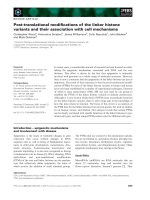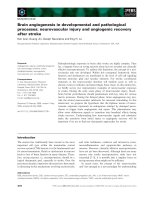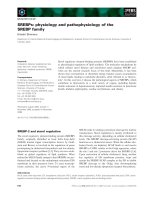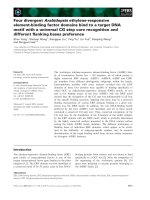Báo cáo khoa học: "Upper abdominal body shape is the risk factor for postoperative pancreatic fistula after splenectomy for advanced gastric cancer: A retrospective study" ppsx
Bạn đang xem bản rút gọn của tài liệu. Xem và tải ngay bản đầy đủ của tài liệu tại đây (476.37 KB, 7 trang )
BioMed Central
Page 1 of 7
(page number not for citation purposes)
World Journal of Surgical Oncology
Open Access
Research
Upper abdominal body shape is the risk factor for postoperative
pancreatic fistula after splenectomy for advanced gastric cancer: A
retrospective study
Naoto Yamamoto*
1
, Takashi Oshima
1
, Tsutomu Sato
1
, Hirochika Makino
1
,
Yasuhiko Nagano
1
, Shoichi Fujii
1
, Yasushi Rino
2
, Toshio Imada
2
and
Chikara Kunisaki
1
Address:
1
Yokohama City University Medical Center, Gastroenterological Surgery, Yokohama, Japan and
2
Yokohama City University, Yokohama,
Japan
Email: Naoto Yamamoto* - ; Takashi Oshima - ; Tsutomu Sato - t-
; Hirochika Makino - ; Yasuhiko Nagano -
cu.ac.jp; Shoichi Fujii - ; Yasushi Rino - ;
Toshio Imada - ; Chikara Kunisaki -
* Corresponding author
Abstract
Background: Postoperative pancreas fistula (POPF) is a major complication after total
gastrectomy with splenectomy. We retrospectively studied the effects of upper abdominal shape
on the development of POPF after gastrectomy.
Methods: Fifty patients who underwent total gastrectomy with splenectomy were studied. The
maximum vertical distance measured by computed tomography (CT) between the anterior
abdominal skin and the back skin (U-APD) and the maximum horizontal distance of a plane at a
right angle to U-APD (U-TD) were measured at the umbilicus. The distance between the anterior
abdominal skin and the root of the celiac artery (CAD) and the distance of a horizontal plane at a
right angle to CAD (CATD) were measured at the root of the celiac artery. The CA depth ratio
(CAD/CATD) was calculated.
Results: POPF occurred in 7 patients (14.0%) and was associated with a higher BMI, longer CAD,
and higher CA depth ratio. However, CATD, U-APD, and U-TD did not differ significantly between
patients with and those without POPF. Logistic-regression analysis revealed that a high BMI (≥25)
and a high CA depth ratio (≥0.370) independently predicted the occurrence of POPF (odds ratio
= 19.007, p = 0.002; odds ratio = 13.656, p = 0.038, respectively).
Conclusion: Surgical procedures such as total gastrectomy with splenectomy should be very
carefully executed in obese patients or patients with a deep abdominal cavity to decrease the risk
of postoperative pancreatic fistula. BMI and body shape can predict the risk of POPF simply by CT.
Published: 10 October 2008
World Journal of Surgical Oncology 2008, 6:109 doi:10.1186/1477-7819-6-109
Received: 22 February 2008
Accepted: 10 October 2008
This article is available from: />© 2008 Yamamoto et al; licensee BioMed Central Ltd.
This is an Open Access article distributed under the terms of the Creative Commons Attribution License ( />),
which permits unrestricted use, distribution, and reproduction in any medium, provided the original work is properly cited.
World Journal of Surgical Oncology 2008, 6:109 />Page 2 of 7
(page number not for citation purposes)
Background
Gastrectomy with D2 lymph node dissection is an estab-
lished procedure for the treatment of gastric cancer in
Japan [1-3]. Japanese retrospective studies have shown
that 20%–30% of patients with advanced cancer of the
proximal stomach have nodal metastasis at the splenic
hilum. Gastrectomy with dissection for these nodes can
yield a 5-year survival of 20%–25%[4].
The most frequent major complication after total gastrec-
tomy with extended dissection is pancreatic fistula [3,5-7].
European clinical trials have shown that pancreatic com-
plications are a major cause of mortality after gastrectomy
[8,9]. Moreover, postoperative pancreatic complications
are difficult to treat and prolong hospitalization.
Total gastrectomy is a challenging procedure, even for
experienced, skilled surgeons because deep sites around
the esophageal hiatus or esophagojejunal anastomosis
have to be dissected. The depth of the surgical sites is
thought to correlate with the difficulty of total gastrec-
tomy, but only a few studies have examined related factors
[10-12].
This study was designed to evaluate the effects of abdom-
inal shape at the umbilicus and the upper abdomen on
short-term surgical outcomes, particularly the incidence
of postoperative pancreas fistula (POPF) in patients
undergoing total gastrectomy with splenectomy.
Methods
Patients
We retrospectively studied 50 consecutive patients with
advanced cancer arising in the upper third of the stomach
who underwent D2 or more extensive total gastrectomy
with splenectomy between January 2004 and August 2006
at the Department of Surgery, Gastroenterological Center,
Yokohama City University. All of the subjects were preop-
eratively confirmed to have gastric adenocarcinoma on
histological examination of endoscopic biopsy speci-
mens. The preoperative evaluation included a barium-
swallow examination, an endoscopic examination with
biopsy, and computed tomography (CT) in all patients.
Abdominal and endoscopic ultrasonography were
optional. Staging and lymph node dissection were per-
formed as recommended by the Japanese Research Society
for Gastric Cancer [13].
Quantification of abdominal shape
All CT were obtained with patients in a supine position,
using a helical CT scanner within 2 months before gastrec-
tomy. The distance between the anterior abdominal skin
and the root of celiac artery was defined as CAD. The dis-
tance of a horizontal plane at a right angle to CAD was
defined as CATD. CAD and CATD were measured on CT
at the level of the root of the celiac artery (Figure. 1a). We
then calculated the CA depth ratio (CAD/CATD) to more
morphologically describe body shape. The maximum ver-
tical distance between the anterior abdominal skin and
the back skin was defined as U-APD. The maximum hori-
Measurement of body shapeFigure 1
Measurement of body shape. Figures 1a and 1b represent the same patient's images who suffered POPF: a 73-year-old male
(gastric cancer), 165 cm, 73 kg, BMI 26.8 kg/m2, CAD 13.1 cm, CATD 32.2 cm, CA-depth ratio 0.407, U-APD 20.0 cm, U-TD
29.0 cm.
World Journal of Surgical Oncology 2008, 6:109 />Page 3 of 7
(page number not for citation purposes)
zontal distance of a plane at a right angle to U-APD was
defined as U-TD. U-APD and U-TD were measured on CT
scans at the level of the umbilicus (Figure. 1b).
Median U-APD, U-TD, CAD, CATD, and CA depth ratio
were 19.0 cm (range 13.0–24.0), 29.0 cm (range 21.0–
35.0), 10.1 cm (range 5.9–14.2), 29.5 cm (range 23.5–
34.2), and 0.370 (range 0.218–0.473), respectively.
Surgical Technique
After transection of the proximal side of the specimen
(usually at the abdominal esophagus), the spleen and
pancreatic tail is removed from the retroperitoneum. The
lymph nodes along the splenic artery are removed, taking
particular care to avoid injuring the pancreas. The splenic
artery is divided at the end of the pancreatic parenchyma.
The splenic vein is ligated and resected at the same level as
the splenic artery. After removing the surgical specimen
(including the stomach, greater and lesser omenta, and
lymph nodes), the correct extent of the retroperitoneal
dissection can be fully assessed. Reconstruction was rou-
tinely done using a Roux-en-Y technique with a stapler
after total gastrectomy; a 25-mm circular stapler was usu-
ally used. All patients received antibiotic prophylaxis for
the same period. Two or more closed-type drains are rou-
tinely applied in the left subphrenic space and around the
stump of duodenum in all patients. Drains are removed
after the 7
th
post operative day if there isn't the incidence
of intraabdominal complication such as anastomotic
leakage or POPF. In case of having intraabdominal infec-
tious complication, we changed drains under radio-
graphic examination and lavaged the cavity through the
drains once or twice a day.
Definition of Postoperative Pancreatic Fistula (POPF)
A case of POPF had to satisfy the criteria for the postoper-
ative pancreatic fistula after pancreaticoduodenectomy:
Output via an operatively placed drain of any measurable
volume of drain fluid on or after postoperative day 3, with
amylase content greater than 3 times the upper normal
serum level [14].
Statistical Analysis
We reviewed the patients' medical charts and surgical
records to obtain the following information: sex (female
or male), body mass index (BMI), age (years, <60 or ≥60),
operation time (minutes, <300 or ≥300), and volume of
bleeding (ml, <500/≥500, <1000/≥1000). Variables of
body shape were classified as follows: BMI (kg/m
2
, <25, or
≥25)[15], U-APD (cm, <19 or ≥19), U-TD (cm, <29 or
≥29), CAD (cm, <10 or ≥10), CATD (cm, <29 or ≥29), and
CA depth ratio (<0.370 or ≥0.370). Variables of body
shape except for BMI were divided into two groups by
median because biologically meaningful cutoff points
could not be defined. Preoperative hemoglobin and albu-
min levels are expressed as means ± SD and were analyzed
with Student's t-test. Frequencies were analyzed using the
χ
2
test or Fisher's exact test. Two-sided p values of less than
0.05 were considered to indicate statistical significance.
All of the factors that were significant in the univariate
analysis were included in the logistic regression analysis.
All analyses were performed using the SPSS program ver-
sion 11.0.1J for Windows (SPSS Inc., Chicago, IL). This
study was approved by our institutional review board.
Results
Clinicopathological characteristics of patients
Pancreatic fistula was diagnosed in 7 of the 50 patients
(14.0%). There was no postoperative death due to pancre-
atic fistula within 30 days or during the hospital stay. The
median age of the patients was 66 years (range 39–82
years), and there were 42 (84%) men and 8 (16%)
women (Table 1). All patients underwent total gastrec-
tomy and pancreas-preserving splenectomy with D2 or
more extended lymph node dissection. The mean opera-
tion time was 346 min (range 197–640). There was no
difference between the patients with POPF and those
without POPF with respect to gender, age, preoperative
serum albumin level, hemoglobin level, operation time,
or the volume of bleeding (Table 1).
Incidence of POPF according to the surgeons' experience
Three different surgeons operated on patients within the
study group. According to the numbers of previous gast-
rectomy combined with splenectomy performed by each
surgeon (<20 cases vs. ≥20 cases), the surgeons' experi-
ence was unrelated to the incidence of POPF; POPF
occurred in 4 of 27 patients who underwent gastrectomy
by one inexperienced surgeons (<20 cases) and in 3 of 23
Table 1: Comparison of clinicopathologic characteristics according to the presence or absence of postoperative pancreatic fistula
POPF(-) POPF(+) P value
Gender, Female/male 8/35 0/7 0.579
Age (yr), <60/≥60 20/23 2/5 0.444
Albumin (g/dl) 3.9 ± 0.5 3.9 ± 0.5 0.794
Hemoglobin (g/dl) 12.7 ± 1.8 13.0 ± 2.7 0.369
Operation time (min), <300/≥300 16/27 3/4 >0.999
Volume of bleeding (ml), <500/≥500, <1000/≥1000 24/14/5 3/2/2 0.484
World Journal of Surgical Oncology 2008, 6:109 />Page 4 of 7
(page number not for citation purposes)
patients who underwent gastrectomy by two experienced
surgeons (≥20 cases) (P > 0.9999).
Correlation of abdominal shape and body mass index with
POPF
Body shape significantly differed between patients with
POPF and those without POPF. POPF was significantly
associated with a higher BMI, longer CAD, and higher CA
depth ratio. However, the presence of POPF was unrelated
to CATD, U-APD, and U-TD (Table 2).
Logistic-regression analysis for the prediction of POPF
The three factors (BMI, CAD, and CA depth ratio) that
were significantly associated with POPF in the univariate
analysis were entered into a logistic-regression analysis.
BMI and CA depth ratio were found to independently pre-
dict the occurrence of POPF (Table 3).
Discussion
Our study showed that a high BMI and larger upper abdo-
men independently influenced the risk of POPF in
patients undergoing total gastrectomy with splenectomy
for advanced gastric cancer. Previously in Japan, pancrea-
ticosplenectomy had been routinely performed to dissect
the lymph nodes along the splenic artery and around the
splenic hilum in patients with gastric cancer in the upper
third of the stomach [16]. However, many centers have
recently reported the benefits of pancreas-preserving
splenectomy [17-20]. Pancreas-preserving total gastrec-
tomy with splenectomy was reported to be superior to
total gastrectomy with pancreaticosplenectomy with
respect to mortality, morbidity, and 5-year survival rate
[4,8,21]. Although POPF developed in 49.7% of the
patients who underwent total gastrectomy with pancreati-
cosplenectomy at our hospital, the present study showed
that the incidence of POPF has decreased to 14.0% since
the introduction of total gastrectomy with pancreas-pre-
serving splenectomy in 2003 [22]. Although modifica-
tions of the surgical procedure and improved
perioperative management have contributed to decreased
morbidity and mortality, POPF remains a severe compli-
cation after total gastrectomy [5,23].
Obesity is a growing problem in developed countries and
substantially increases the risks of morbidity and mortal-
ity associated with abdominal surgery [24-27]. BMI is con-
sidered a predictor of surgical outcomes in patients with
different types of cancer, including colonic, breast, and
endometrial malignancies [28-31]. Kodera et al reported
that obesity increase the risk of surgical complications in
patients who undergo distal gastrectomy with D2 lym-
phadenectomy [32]. Our study showed that a high BMI
influences the risk of postoperative pancreas-related com-
plications. This finding is consistent with the results of a
previous study showing that being overweight increases
the risk of surgical complications, including pancreatic fis-
tula, in patients who undergo D2 dissection for gastric
cancer [26].
Abdominal shape may also influence accessibility in
patients with gastric cancer. Total gastrectomy with
splenectomy is a more difficult procedure at deeper surgi-
cal sites because dissection is required around the esopha-
geal hiatus or esophagojejunal anastomosis. Moreover, a
large anterior-to-posterior abdominal wall diameter may
make it difficult to dissect along the splenic artery or to
mobilize the spleen in deep sites of the abdominal cavity.
Lee et al. reported that obesity and abdominal shape at the
umbilical level both influence the short-time outcomes of
subtotal gastrectomy with D2 lymph node dissection in
patients with gastric cancer [33]. In our study, we meas-
ured CAD and CATD to quantify upper abdominal shape,
unlike previous studies [33]. We believe that a higher CA
depth ratio requires a deeper surgical site. We found that
upper abdominal shape as represented by CAD or CA
depth ratio was related to the incidence of POPF, whereas
body shape at the umbilicus was not. Tsukada et al.
reported that accumulation of body fat is significantly
associated with postoperative complications after elective
gastric or colorectal surgery [27]. Seki et al. measured the
visceral fat mass by using software to estimate fat volume,
and examined the relation to operative time in patients
with rectosigmoid cancer. They concluded that the
amount of visceral fat was a more useful predictor of oper-
ative difficulty than was BMI [34]. Because we did not
measure the amount of body fat in our study, the relations
among upper abdominal shape, body fat amount, and
POPF remain unclear.
Although, age, BMI, serum zinc level, hyperlipidemia, and
comorbidity were significantly related to the incidence of
POPF after pancreaticosplenectomy for advanced gastric
cancer in our previous study [22], none of these factors,
except for BMI, was positively associated with the inci-
dence of POPF in this study. In contrast, we found that the
shape of the upper abdomen significantly correlated with
POPF. One of the reasons for the inconsistent results
might be the difference in the operative procedures (pan-
Table 2: Comparison of BMI and body shape according to the
presence or absence of postoperative pancreatic fistula
POPF(-) POPF(+) P value
Body mass index (kg/m
2
), <25/≥25 39/4 3/4 0.009
CAD (cm), <10/≥10 25/18 1/6 0.045
CATD (cm), <29/≥29 23/20 2/5 0.417
U-APD (cm), <19/≥19 23/20 2/5 0.417
U-TD (cm), <29/≥29 29/14 3/4 0.234
CA depth ratio, <0.370/≥0.370 36/7 2/5 0.006
World Journal of Surgical Oncology 2008, 6:109 />Page 5 of 7
(page number not for citation purposes)
creaticosplenectomy vs. pancreas-preserving splenec-
tomy).
It is well-known that abdominal adiposity is strongly
associated with increased incidence of diabetes mellitus
(DM) which may also contribute to post-operative com-
plication [4,35,36]. Russo et al. demonstrating that obes-
ity and DM were independent predictors of surgical
complication [37]. In our study, there were only 8 of 50
patients with DM. Among these patients, there was no sig-
nificant difference of the incidence of POPF between the
patients with and without DM.
Mathur et al. reported that fatty pancreas is risk of postop-
erative pancreatic leakage after pancreatoduodenectomy
[38]. Kovanlikaya et al reported that there are positively
correlated BMI and pancreatic fat content by magnetic res-
onance imaging [39]. Much visceral fat around pancreas is
thought to make it hard to identify a border between pan-
creatic parenchyma and surrounding tissue. Therefore,
there might be the risk for damaging the pancreatic sub-
stance without noticing. In our present study, no prospec-
tive data are available to correlate the texture of the
pancreas. Therefore, future studies should be designed to
capture this information and investigate the risk of POPF
by analyzing the correlation between body shape, visceral
fat around pancreas, and the texture of the pancreas.
It is thought that surgical procedure in a deep abdominal
cavity such as left subphrenic space, dissection and liga-
tion need particular skill. We think that it is easy for an
experienced surgeon to imagine that the bleeding due to
injury of the spleen is caused by immature surgical
maneuver. It has been reported about utility of Ligasure™
in an operation of gastric cancer by randomized study
[40]. We think that we can manipulate effectively and
safety by using new surgical instrument (Ligasure™) in
such a deep operation field, and we can perform safe
maneuver recently. Therefore, the incidence of POPF
might be low.
There are several potential limitations of our study. First,
a major limitation of our study was the low-power statis-
tics because of the small number of patients enrolled to
this study. At our institution, although most patients with
advanced gastric cancer are treated by total gastrectomy
with splenectomy, most patients with early gastric cancer
in the upper third of the stomach are treated by proximal
gastrectomy or total gastrectomy without splenectomy.
Hence it is difficult to collect large numbers of patients
who underwent total gastrectomy with splenectomy.
Splenectomy has been advocated to facilitate dissection of
lymph nodes at the splenic hilum and along the splenic
artery [4,41,42], and total gastrectomy without splenec-
tomy has been performed for early gastric cancer which
maneuver around pancreas is omitted by reduced range of
lymphadenectomy. Therefore, we reviewed about inci-
dence of a pancreas-related complication after splenec-
tomy. Second, the proportion of patients with high BMI
(BMI ≥ 25) in this study was low (16.0%). Therefore, the
obtained results are not definitely conclusive, but our
results suggest that caution is needed when performing
total gastrectomy with splenectomy for gastric cancer in
overweight patients. Third, a major limitation of our study
was the low-power statistics because of the low incidence
of POPF. Although mortality rates from gastrectomy com-
plicated by pancreas-related abscess are lower in Japan
than those reported in Western series [8,9], pancreas
related abscess formation remains a strong factor in the
mortality and morbidity rates in both Japanese and West-
ern centers. Thus we think a large study will be necessary
to obtain a definitive conclusion.
It does not have doubt that BMI is useful when we evalu-
ate difficulty of operation for obese patient. However, in
our result, there were not many cases with BMI high level.
By contrast, there were some cases having high level of CA
depth ratio in spite of low BMI. Therefore, we think it is
important to measure upper abdominal body shape.
Conclusion
In conclusion, our results indicate that surgical procedures
such as total gastrectomy with splenectomy should be
very carefully executed in obese patients or patients with a
deep abdominal cavity to decrease the risk of postopera-
tive pancreatic fistula. It is easy to measure the CAD and
CATD at the level of the root of celiac artery by preopera-
tive CT, and we can also do it retrospectively. Thus, CAD
and CATD should be routinely evaluated in patients who
undergo upper abdominal surgery particularly total gast-
rectomy with splenectomy. A worldwide study will be
necessary to obtain a definitive conclusion.
Table 3: Predictive factors for POPF as assessed by logistic-regression analysis
Odds ratio (95% Confidence Interval) P value
Body mass index (kg/m
2
), <25/≥25 19.0 (2.8 – 127.0) 0.002
CA depth ratio, <0.370/≥0.370 13.7 (1.2 – 161.7) 0.038
World Journal of Surgical Oncology 2008, 6:109 />Page 6 of 7
(page number not for citation purposes)
Competing interests
The authors declare that they have no competing interests.
Authors' contributions
TS, HM, YN and SF carried out collection of data, and NY
drafted the manuscript. TO and YR participated in the
design of the study and performed the statistical analysis.
CK and TI conceived of the study, and participated in its
design and coordination and helped to draft the manu-
script. All authors read and approved the final manu-
script.
Acknowledgements
The authors thank Dr. S. Morita MD. for excellent statistical advices.
References
1. Kaminishi M, Shimoyama S, Yamaguchi H, Yamada H, Ogawa T, Kawa-
hara M, Joujima Y, Oohara T: Results of subtotal gastrectomy
with complete dissection of the N2 lymph nodes preserving
the spleen and pancreas in surgery for gastric cancer. Hepa-
togastroenterology 1994, 41:384-387.
2. Degiuli M, Sasako M, Ponzetto A, Allone T, Soldati T, Calgaro M, Bal-
cet F, Bussone R, Olivieri F, Scaglione D, et al.: Extended lymph
node dissection for gastric cancer: results of a prospective,
multi-centre analysis of morbidity and mortality in 118 con-
secutive cases. Eur J Surg Oncol 1997, 23:310-314.
3. Furukawa H, Hiratsuka M, Ishikawa O, Ikeda M, Imamura H, Masutani
S, Tatsuta M, Satomi T: Total gastrectomy with dissection of
lymph nodes along the splenic artery: a pancreas-preserving
method. Ann Surg Oncol 2000, 7:669-673.
4. Maruyama K, Sasako M, Kinoshita T, Sano T, Katai H, Okajima K:
Pancreas-preserving total gastrectomy for proximal gastric
cancer. World J Surg 1995, 19:532-536.
5. Sasako M, Katai H, Sano T, Maruyama K: Management of compli-
cations after gastrectomy with extended lymphadenectomy.
Surg Oncol 2000, 9:31-34.
6. Kostic Z, Cuk V, Ignjatovic M, Usaj-Knezevic S: [Early complica-
tions following radical surgical treatment of patients with
gastric adenocarcinoma]. Vojnosanit Pregl 2006, 63:249-256.
7. Szucs G, Toth I, Gyani K, Kiss JI: [Effect of extending the resec-
tion on postoperative complications of total gastrectomies:
experience with 161 operations]. Magy Seb 2002, 55:362-368.
8. Bonenkamp JJ, Songun I, Hermans J, Sasako M, Welvaart K, Plukker
JT, van Elk P, Obertop H, Gouma DJ, Taat CW, et al.: Randomised
comparison of morbidity after D1 and D2 dissection for gas-
tric cancer in 996 Dutch patients. Lancet 1995, 345:745-748.
9. Cuschieri A, Fayers P, Fielding J, Craven J, Bancewicz J, Joypaul V,
Cook P: Postoperative morbidity and mortality after D1 and
D2 resections for gastric cancer: preliminary results of the
MRC randomised controlled surgical trial. The Surgical
Cooperative Group. Lancet 1996, 347:995-999.
10. Roukos DH:
Current advances and changes in treatment
strategy may improve survival and quality of life in patients
with potentially curable gastric cancer. Ann Surg Oncol 1999,
6:46-56.
11. Siewert JR, Stein HJ, Sendler A, Fink U: Surgical resection for can-
cer of the cardia. Semin Surg Oncol 1999, 17:125-131.
12. Stein HJ, Feith M, Siewert JR: Cancer of the esophagogastric
junction. Surg Oncol 2000, 9:35-41.
13. Japanese Gastric Cancer Association. Japanese Classification of Gastric Car-
cinoma: 2nd English Edition 1998.
14. Bassi C, Dervenis C, Butturini G, Fingerhut A, Yeo C, Izbicki J, Neop-
tolemos J, Sarr M, Traverso W, Buchler M: Postoperative pancre-
atic fistula: an international study group (ISGPF) definition.
Surgery 2005, 138:8-13.
15. Seidell JC, Flegal KM: Assessing obesity: classification and epide-
miology. Br Med Bull 1997, 53:238-252.
16. Cuschieri A, Weeden S, Fielding J, Bancewicz J, Craven J, Joypaul V,
Sydes M, Fayers P: Patient survival after D1 and D2 resections
for gastric cancer: long-term results of the MRC randomized
surgical trial. Surgical Co-operative Group. Br J Cancer 1999,
79:1522-1530.
17. Monig SP, Collet PH, Baldus SE, Schmackpfeffer K, Schroder W,
Thiele J, Dienes HP, Holscher AH: Splenectomy in proximal gas-
tric cancer: frequency of lymph node metastasis to the
splenic hilus. J Surg Oncol 2001, 76:89-92.
18. Liotta G, Federici O: [D2 pancreas-preserving lymphadenec-
tomy in tumors of the upper third of the stomach]. Tumori
2003, 89:67-69.
19. Degiuli M, Sasako M, Ponti A, Calvo F: Survival results of a multi-
centre phase II study to evaluate D2 gastrectomy for gastric
cancer. Br J Cancer 2004, 90:1727-1732.
20. Koufuji K, Shirouzu K, Aoyagi K, Yano S, Miyagi M, Imaizumi T,
Takeda J: Surgery and clinicopathological features of gastric
adenocarcinoma involving the esophago-gastric junction.
Kurume Med J 2005, 52:73-79.
21. Okajima K, Isozaki H: Splenectomy for treatment of gastric
cancer: Japanese experience. World J Surg 1995, 19:537-540.
22. Kunisaki C, Shimada H, Ono H, Otsuka Y, Matsuda G, Nomura M,
Akiyama H: Predictive factors for pancreatic fistula after pan-
creaticosplenectomy for advanced gastric cancer in the
upper third of the stomach. J Gastrointest Surg 2006, 10:132-137.
23. Ichikawa D, Kurioka H, Yamaguchi T, Koike H, Okamoto K, Otsuji E,
Shirono K, Shioaki Y, Ikeda E, Mutoh F, Yamagishi H: Postoperative
complications following gastrectomy for gastric cancer dur-
ing the last decade. Hepatogastroenterology 2004, 51:613-617.
24. Kodera Y, Sasako M, Yamamoto S, Sano T, Nashimoto A, Kurita A:
Identification of risk factors for the development of compli-
cations following extended and superextended lym-
phadenectomies for gastric cancer. Br J Surg 2005,
92:1103-1109.
25. Dhar DK, Kubota H, Tachibana M, Kotoh T, Tabara H, Masunaga R,
Kohno H, Nagasue N: Body mass index determines the success
of lymph node dissection and predicts the outcome of gastric
carcinoma patients. Oncology 2000, 59:18-23.
26. Tsujinaka T, Sasako M, Yamamoto S, Sano T, Kurokawa Y, Nashimoto
A, Kurita A, Katai H, Shimizu T, Furukawa H, et al.: Influence of
overweight on surgical complications for gastric cancer:
results from a randomized control trial comparing D2 and
extended para-aortic D3 lymphadenectomy (JCOG9501).
Ann Surg Oncol 2007, 14:355-361.
27. Tsukada K, Miyazaki T, Kato H, Masuda N, Fukuchi M, Fukai Y, Naka-
jima M, Ishizaki M, Motegi M, Mogi A, et al.: Body fat accumulation
and postoperative complications after abdominal surgery.
Am Surg 2004, 70:347-351.
28. Lee CT, Dunn RL, Chen BT, Joshi DP, Sheffield J, Montie JE: Impact
of body mass index on radical cystectomy. J Urol 2004,
172:1281-1285.
29. Leroy J, Ananian P, Rubino F, Claudon B, Mutter D, Marescaux J: The
impact of obesity on technical feasibility and postoperative
outcomes of laparoscopic left colectomy. Ann Surg 2005,
241:69-76.
30. Erkanli S, Kayaselcuk F, Bagis T, Kuscu E: Impact of morbid obesity
in surgical management of endometrial cancer: surgical
morbidity, clinical and pathological aspects. Eur J Gynaecol
Oncol 2006, 27:401-404.
31. El-Tamer MB, Ward BM, Schifftner T, Neumayer L, Khuri S, Hender-
son W: Morbidity and mortality following breast cancer sur-
gery in women: national benchmarks for standards of care.
Ann Surg 2007, 245:665-671.
32. Kodera Y, Ito S, Yamamura Y, Mochizuki Y, Fujiwara M, Hibi K, Ito K,
Akiyama S, Nakao A: Obesity and outcome of distal gastrec-
tomy with D2 lymphadenectomy for carcinoma. Hepatogas-
troenterology 2004, 51:1225-1228.
33. Lee JH, Paik YH, Lee JS, Ryu KW, Kim CG, Park SR, Kim YW, Kook
MC, Nam BH, Bae JM: Abdominal shape of gastric cancer
patients influences short-term surgical outcomes. Ann Surg
Oncol 2007, 14:1288-1294.
34. Seki Y, Ohue M, Sekimoto M, Takiguchi S, Takemasa I, Ikeda M,
Yamamoto H, Monden M: Evaluation of the technical difficulty
performing laparoscopic resection of a rectosigmoid carci-
noma: visceral fat reflects technical difficulty more accu-
rately than body mass index. Surg Endosc 2007, 21:929-934.
35. Fernandez-Real JM, Vayreda M, Casamitjana R, Saez M, Ricart W:
[Body mass index (BMI) and percent fat mass. A BMI > 27.5
Publish with BioMed Central and every
scientist can read your work free of charge
"BioMed Central will be the most significant development for
disseminating the results of biomedical research in our lifetime."
Sir Paul Nurse, Cancer Research UK
Your research papers will be:
available free of charge to the entire biomedical community
peer reviewed and published immediately upon acceptance
cited in PubMed and archived on PubMed Central
yours — you keep the copyright
Submit your manuscript here:
/>BioMedcentral
World Journal of Surgical Oncology 2008, 6:109 />Page 7 of 7
(page number not for citation purposes)
kg/m2 could be indicative of obesity in the Spanish popula-
tion]. Med Clin (Barc) 2001, 117:681-684.
36. Miyatake N, Takanami S, Kawasaki Y, Fujii M: Relationship
between visceral fat accumulation and physical fitness in Jap-
anese women. Diabetes Res Clin Pract 2004, 64:173-179.
37. Russo PL, Spelman DW: A new surgical-site infection risk index
using risk factors identified by multivariate analysis for
patients undergoing coronary artery bypass graft surgery.
Infect Control Hosp Epidemiol 2002, 23:372-376.
38. Mathur A, Pitt HA, Marine M, Saxena R, Schmidt CM, Howard TJ,
Nakeeb A, Zyromski NJ, Lillemoe KD: Fatty pancreas: a factor in
postoperative pancreatic fistula. Ann Surg 2007, 246:1058-1064.
39. Kovanlikaya A, Mittelman SD, Ward A, Geffner ME, Dorey F, Gilsanz
V: Obesity and fat quantification in lean tissues using three-
point Dixon MR imaging. Pediatr Radiol 2005, 35:601-607.
40. Lee WJ, Chen TC, Lai IR, Wang W, Huang MT: Randomized clini-
cal trial of Ligasure versus conventional surgery for
extended gastric cancer resection. Br J Surg 2003,
90:1493-1496.
41. Soga J, Kobayashi K, Saito J, Fujimaki M, Muto T: The role of lym-
phadenectomy in curative surgery for gastric cancer. World J
Surg 1979, 3:701-708.
42. Wanebo HJ, Kennedy BJ, Winchester DP, Stewart AK, Fremgen AM:
Role of splenectomy in gastric cancer surgery: adverse effect
of elective splenectomy on longterm survival. J Am Coll Surg
1997, 185:177-184.




